

LEADERSHIP COACHING: VALUING STUDENT VOICE — Jimmy Casas. How to Innovate Teaching Practices Without Abandoning What Works. Tell me if this sounds familiar: A consultant or speaker came to your school or a conference you attended to talk about an amazing new teaching approach—maybe it was project-based learning, genius hour, STEM, flipped classrooms, or makerspaces.
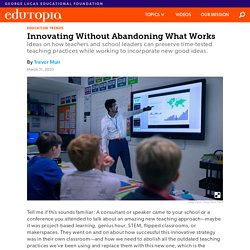
They went on and on about how successful this innovative strategy was in their own classroom—and how we need to abolish all the outdated teaching practices we’ve been using and replace them with this new one, which is the greatest pedagogical approach of all time. And perhaps while they were showing pictures from their classroom of kids building race cars, swiveling around on thousand-dollar office chairs, and making keychains with a 3D printer, you couldn’t help but think about the desks in your classroom that have been there since before the moon landing. Or the fact that you haven’t been given a supply budget in four years, and that the only race cars your students are building are made out of toilet paper rolls you brought from home. Teaching Reading is an Art as well as a Science - The Robb Review Blog. Timothy Rasinski, Ph.D.
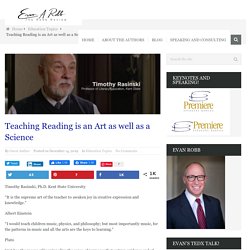
Kent State University “It is the supreme art of the teacher to awaken joy in creative expression and knowledge.” Albert Einstein “I would teach children music, physics, and philosophy; but most importantly music, for the patterns in music and all the arts are the keys to learning.” 50 Alternatives To Lecturing. By TeachThought Staff As teachers, when we lecture, we have the best of intentions.

We have a concept we want the class to understand, so we stand and explain it to them. We give them background. Offer details. Anticipate and pre-empt common misconceptions. What to know about mental health and back to school. How is summer already over?
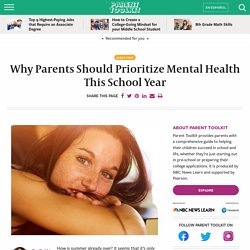
It seems that it’s only just begun. The reality is the kids will be back to middle and high school before the last sip of summer is had. And with the new year, there are often new challenges. As many say, “Little kids, little problems. Big kids, big problems.” 5 Strategies to Demystify the Learning Process for Struggling Students. Oakley recognizes that “many educators are not at all comfortable with or trained in neuroscience,” so she breaks down a few key principles that teachers can use in the classroom and share with students to help them demystify the learning process. 1. The Hiker Brain vs. The Race Car Brain Start by teaching students the difference between focused and diffused thinking, says Oakley. When the brain is in focused mode, you can get started on the task at hand.
5 Strategies to Demystify the Learning Process for Struggling Students. K-12 Education Tips & Strategies That Work. The Emotional Labor of Teaching and the Need for Systemic Change. Early in my teaching career, I made my second-grade class cry.
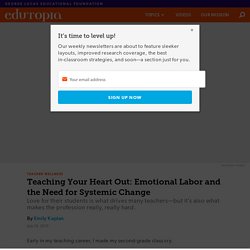
I didn’t mean to. I was teaching a lesson on writing with detail. My students—7- and 8-year-olds living in a big city, many of them in poverty—were sitting around me in a circle, notebooks and pencils in their laps. We were at the beginning of the unit, and I was modeling the process of coming up with an idea. “As writers, sometimes it helps to think of a time when we had a big feeling, like being happy, or angry, or sad.” My students were looking at me with total attention—something that didn’t happen often. Suddenly, a little voice piped up: “My uncle died.” Silence. What Is the Purpose of High School? To prepare students for adulthood, not necessarily for college It is dawning on more and more people that we need to rethink our approach to higher education.

For decades, both the government and the culture have sought to steer young people toward college as the path to both their individual and our national success. That strategy appears to have hit a point of diminishing returns. In the model we have held out, young people will finish high school, enroll in college, receive a degree, and then begin careers that require college diplomas. But a significant percentage of Americans fail to make it from one step to the next, and public concern has really focused only on raising the percentage of people who take the first two steps. It’s chiefly people who study the issue who are even aware of just how high college-dropout rates are. In a paper for the Manhattan Institute, Oren Cass estimates that only around one-sixth of young people are following the path our system lays out for them. 60formativeassessment. What Happens When Teachers Start Stepping Out Of Their Comfort Zone -
What Happens When Teachers Start Stepping Out Of Their Comfort Zone by TeachThought Staff What happens when, as a teacher, you step out of your comfort zone?
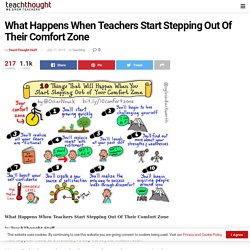
We’ve talked in the past about what happens when teachers connect, but that doesn’t necessarily require a teacher to push past their usual habits and routines. Much like adopting a growth mindset, valuing the act of pushing past what you “like to do” can, in the right circumstance, result in growth. Education’s resident colorful sketchnoter Sylvia Duckworth took Oskar Nowik’s thoughts on the benefits of stepping out of your comfort zone and, true to form, created a graphic. We, as educators, face countless opportunities on a daily basis to change, but not all change is growth. 6 Great Google Slides Add-ons for Teachers. Use Google Sheets to Create Online Bingo Boards With Pictures.
Flippity is one of my favorite Google Sheets Add-ons because it gives you direct access to sixteen templates that you can use to create games, progress trackers, and random name selectors.
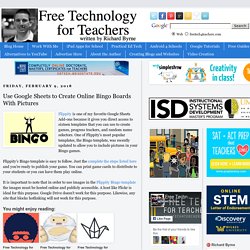
One of Flippity's most popular templates, the Bingo template, was recently updated to allow you to include pictures in your Bingo games. Flippity's Bingo template is easy to follow. Just the complete the steps listed here and you're ready to publish your game. Managing Your High School Classroom with Compassion. There is no one-size-fits-all approach for classroom management; the methods for discipline need to be as diverse and unique as the students themselves.
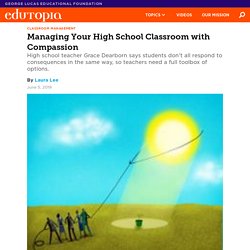
But according to Grace Dearborn—a high school teacher and the author of the books Picture This! And Conscious Classroom Management—a common thread should run through them all: compassion. In a recent piece on Mindshift, editor Ki Sung provides Dearborn's tips on compassion-based classroom behavior management. Promoting Deeper Reading Comprehension in Elementary School. Collaborative reading is one of several strategies at Concourse Village Elementary School (CVES) that are meant to incorporate literacy into all aspects of the curriculum.
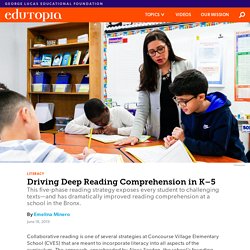
The approach, spearheaded by Alexa Sorden, the school’s founding principal and a former literacy coach, is a marriage of shared reading—students read a text together, guided by the teacher—and close reading, which has students work independently and in small groups to produce a critical analysis of a text. Classes in all grades in the pre-K to 5 school spend 15 to 20 minutes every day deconstructing an above-grade-level text of up to 150 words. The approach breaks down the reading process into five phases that emphasize repeated exposure to the text to drive deep comprehension: understanding the main idea, annotating the text, identifying key ideas and details, dissecting the author’s craft, and summarizing (download a PDF of the five phases).
Getting Started. Classroom displays: why they don't work. Classroom displays: a topic that divides the teaching community like no other. Some people love their displays of pupils’ work or of subject information. They’ll spend hours triple-mounting pieces of paper on complementary colours and laying them out with care and dedication.
Others, however, argue that such classroom displays offer little in terms of pupil learning and may actually do more harm than good. How To Scaffold Learning Through Station Teaching. How To Scaffold Learning Through Station Teaching by TeachThought Staff Teaching through stations—or ‘station teaching’—is a flexible and underrated teaching and learning strategy that can add versatility to your craft. This approach requires unique classroom management strategies, precise time management, and a clear relationship between the design of each station and the learning objective itself. If you can meet these demands, station teaching can allow you to differentiate and personalize learning for students, meeting their needs while reducing your workload.
See also 12 Types Of Blended Learning. What Is A Student Responsible For? What Is A Student Responsible For? A Strategy for Reducing Math Test Anxiety. A Teacher’s Policy for Letting Students Retake Tests and Assignments. As a young teacher, I would tell my students that hard work doesn’t always equate with success. Instead, I encouraged them to work smarter, not necessarily harder, for the next big test or writing assignment.
Restorative Practices DO Include Accountability Measures. Restorative justice practices have been increasing over the last decade, but many school leaders remain hesitant to implement them. The co-founders of BehaviorFlip, Brad Weinstein and Nathan Maynard, believe that this is due to misconceptions about restorative practices. 5 Effective Studying Techniques That Are Backed by Research. Too often people imagine that long hours of studying are the best path to being a model, straight-A student. Providing Differentiated Instruction by Giving Students Choices. Most classrooms are filled with students of varying academic abilities. Even within a gifted and talented classroom like mine, the ability levels can range drastically.
The Biggest Lesson of My First Year Teaching. Overwhelming is the word that best describes my first year of teaching. I wasn’t prepared for the multitude of things on my plate. 4 Ways a Learning Management System Can Benefit Students With ADHD. Overcoming Test Anxiety in High School. In High School, the Kids Are Not All Right. Using Literacy Skills to Solve Math Word Problems. When Concourse Village Elementary School (CVES) opened in 2013 in the wake of the planned phaseout of P.S. 385, which the New York City Department of Education had tagged with a D, students were struggling academically. Putting an End to Fake Reading. 7 Smart, Fast Ways to Do Formative Assessment. How To Fix A Talkative Class. How To Avoid Big, Dramatic Misbehavior. A Fun Way To Teach Students How Not To Behave. How To Avoid Angry Parent Complaints. How To Handle Parents Who Complain About Their Child Being Held Accountable.
End of the Year. Protecting Student Privacy on Social Media: Do's and Don'ts for Teachers. 25 Teaching Tools To Organize, Innovate, & Manage Your Classroom. Edutopia. Edutopia. Allowing Test Retakes—Without Getting Gamed.
Using a Social Media Account With Your K–12 Class. Early Childhood Math Education: What the Research Says. Modeling the Writing Process for Students. Deepening Student Understanding with Collaborative Discourse. We Have a National Reading Crisis. It’s Time for a Curriculum PLN – Curriculum Matters. When School Is Nothing Like The World Students Live In.
20 Collaborative Learning Tips And Strategies For Teachers. 8 Wildly Successful Classroom Management Strategies for 2019. What if Students Designed Their Education? How To Create A No-Zero Policy In Your Classroom. A Letter Grade Isn’t A Letter Grade: Why We Should Stop Averaging Scores - Where Has The Joy Of Learning Gone? 6 Powerful Strategies For Deeper Learning In Your Classroom. 8 Most Common Sources Of Formative Assessment Data - TeachThought. Creating a Digital Rubric with Google Forms and autoCrat — Hello, Teacher Lady. How Do You Know When A Teaching Strategy Is Most Effective? John Hattie Has An Idea. Every teacher needs a 'reflection buddy' to keep them sane. Vaping sent this teenager into rehab. His parents blame Juul's heavy nicotine dose.
Five Clever Ideas to Spark Independent Reading by Kids. 10 Empowering Messages to Share With Your Students. Vaping sent this teenager into rehab. His parents blame Juul's heavy nicotine dose. 5 New Year’s Resolutions for the Classroom! 5 Thoughts to Improve Your Mental Approach as an Educator. What Is Generation Z, And What Does It Want?
The Reading Principle: Three Types of Reading - The Robb Review Blog. How Do You Know When A Teaching Strategy Is Most Effective? John Hattie Has An Idea. The Five-Paragraph Essay Must Die - Pacific Standard. Why Students Forget—and What You Can Do About It. Choice page. What Works Best. Transforming the First Ten Minutes of Class – Heinemann Publishing. 25 Ideas to Motivate Young Readers. Why Executive Function Is A Vital Stepping-Stone For Kids' Ability to Learn. 11 Alternatives to "Round Robin" (and "Popcorn") Reading. One & Done Workout Program. I Traveled Across 14 States and Every Student Told Me the Same Story About Why They're Not Motivated in the Classroom.
Why Prosody Matters: The Importance of Reading Aloud with Expression. Holy shit. This commercial. Trainugly. What is Your Mindset? – Believe In Yet: Bringing Mindset into Education. Project or Activity? Project-Based Learning and Cousins. High-Impact Instructional Strategies To Use Right Now. After Accelerated Reader. A Growth Mindset: Starting with Ourselves. Share.teacher2teacher. Quick daily timed writes, when paired with peer feedback, help kids gain confidence as writers.… 4 Strategies for Teaching Students How to Revise.
A simple way to build students’ enthusiasm for daily writing.… Edutopia. After Accelerated Reader. 10 Tips for New Teachers. How does NoRedInk map to state and national standards and assessments? – NoRedInk Help Center.